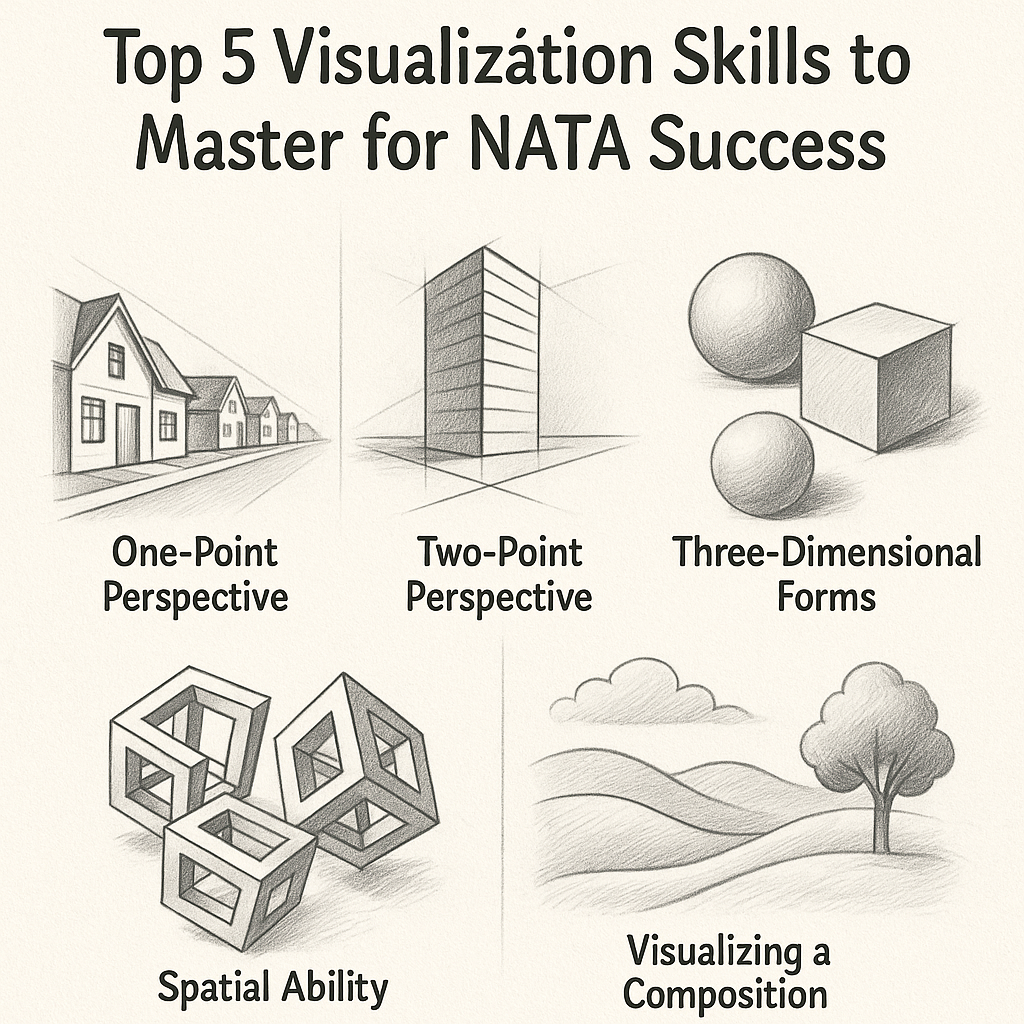
The NATA (National Aptitude Test in Architecture) is more than a test—it’s a gateway into the world of spatial intelligence, creativity, and design thinking. To truly excel, you must develop strong visualization skills—your ability to mentally picture forms, spaces, and transformations.
Here are the Top 5 Visualization Skills you need to master, complete with techniques and tips to sharpen your mind and pencil for NATA success.
🧠 1. Spatial Reasoning: See It from Every Angle
Why it matters: Architecture is about understanding space in 3D—how a structure looks from above, below, and from all sides. Spatial reasoning helps you imagine and manipulate 3D objects mentally.
✏️ Practice Techniques:
- 3D Object Rotation: Practice drawing cubes, cylinders, and cones from various angles.
- Net to Solid Transformation: Study how 2D nets fold into 3D forms.
- Use Everyday Objects: Observe a chair, water bottle, or box—then draw it from an unfamiliar angle.
🧩 Bonus Tip:
Use building blocks, puzzles, or modeling apps like “Shapr3D” to strengthen spatial memory.
🔲 2. 2D to 3D Conversion: Bring Flat Designs to Life
Why it matters: This is crucial for perspective drawing. You need to visualize how a 2D plan looks when it becomes a real structure.
✏️ Practice Techniques:
- Draw Plans & Elevations: Sketch a floor plan and try to visualize how the space would look in 3D.
- One-point and Two-point Perspective Grids: Use grid-based exercises to convert shapes into dimensional forms.
- Construct Paper Models: Create origami or simple architectural models from paper nets.
🧠 Bonus Tip:
Challenge yourself to mentally convert 2D floor plans into 3D environments as you walk through real buildings.
👁️ 3. Observation & Detail Recall: Train Your Visual Memory
Why it matters: In the drawing section, you may be asked to recreate a scenario from memory. A keen eye helps capture real-world references accurately.
✏️ Practice Techniques:
- Memory Sketching: Observe a scene or object for 30 seconds, then draw it from memory.
- Daily Sketchbook Entries: Sketch a small object every day with maximum detail—shadows, textures, and proportion.
- Photo to Sketch: Pick a photo and sketch it from a different perspective.
📸 Bonus Tip:
Practice recalling how light falls on surfaces—this builds your understanding of form and depth.
🏛️ 4. Imagination & Composition: Create Scenes from Scratch
Why it matters: NATA values original compositions. Being able to imagine spaces, characters, and stories and arrange them meaningfully is essential.
✏️ Practice Techniques:
- Creative Scenario Drawing: Imagine and sketch scenes like “Inside a Future Library” or “A Floating Café.”
- Use the Rule of Thirds: Learn how to balance visual weight in your composition.
- Add Narrative Layers: Think about the story behind the scene—what’s happening, and why?
💭 Bonus Tip:
Create theme-based doodles—like “Life Underwater” or “Space City”—to stretch your imagination.
📐 5. Perspective Mastery: Depth, Angles, and Accuracy
Why it matters: This is the backbone of architectural drawing. Getting perspective right makes your spaces look realistic and dynamic.
✏️ Practice Techniques:
- Draw Interiors and Exteriors: Start with rooms in your home, then sketch streetscapes using vanishing points.
- Use Horizon Lines and VPs: Practice placing vanishing points and drawing shapes within that grid.
- Layer with Shadows: Add shadows and lighting to reinforce depth.
📏 Bonus Tip:
Try “Urban Sketching” outdoors—public parks, buildings, streets. It improves real-world spatial awareness.
🧾 Summary Table:
| Skill | What It Trains | Practice |
|---|---|---|
| Spatial Reasoning | 3D Manipulation | Object rotation drills |
| 2D to 3D Conversion | Depth & perspective | Plan to form practice |
| Observation & Memory | Visual accuracy | Quick recall sketches |
| Imagination & Composition | Originality | Scenario drawing |
| Perspective Drawing | Realism | Vanishing point sketches |
✨ Final Word:
Visualization is not just a skill—it’s the language of architects. Mastering these five areas will not only help you crack NATA, but also prepare you for a creative journey in design. The more you observe, imagine, and draw, the stronger your visualization power becomes.
Want to succeed your pursuit of a dream career.? Join our effective training course for NID Entrance Test. Call / WhatsApp: +91 9902739994
